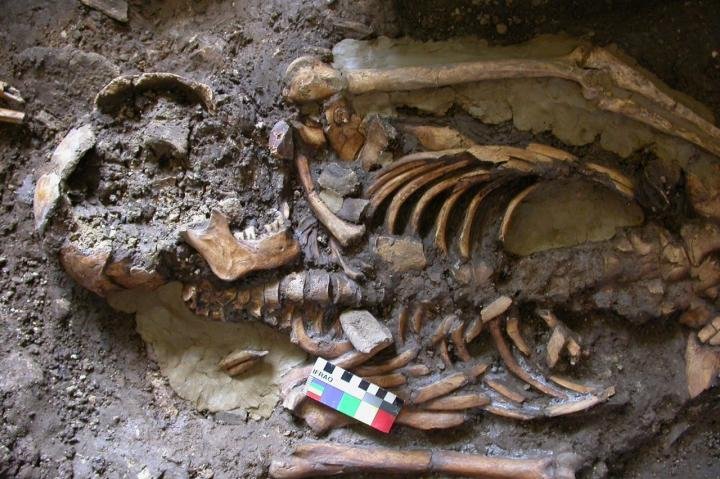DNA extracted from 10,000-year-old skeletal remains, found in the Caucasus Mountains, have revealed the "fourth strand" of European ancestry. Photo by Eppie Jones
CAMBRIDGE, England, Nov. 16 (UPI) -- The origins of modern Europeans' genetic makeup is becoming clearer. Scientists have found the "fourth strand" of European ancestry.
A small but significant portion of Europe's genome is derived from a unique population of hunter-gatherers who for several thousand years sat out the frigid intolerance of the Ice Age in the shelter of the Caucasus mountains.
Shortly after the Out of Africa movement, a group of hunter-gatherers split off from western populations and settled the lands along the present day Russian-Georgian border. There, hemmed in by ice and snow, they remained isolated for several thousand years, their genetic makeup growing more distinct.
At some point after the the last Ice Age finally began to recede, approximately 22,000 years ago, the Caucasus peoples joined the Yamnaya culture, the horse-borne Steppe herders of Eastern Europe. Around 5,000 years ago, the Yamnaya culture swept into Western Europe.
They brought considerable metal-working skills with them, and some anthropologists believe their arrival ushered in the Bronze Age. They also brought the family of Indo-European languages that would birth the tongues of modern Europe. Central and Northern Europe owe as much as half of their ancestry to the Yamnaya herders.
Researchers have long been aware the Yamnaya's influence of Europe's genome and vocabulary, but the Steppe herders themselves were a mixed people. The latest discovery, made possible by sequencing ancient genomes from the Caucasus region, shows where exactly some of that mixing came from.
The DNA was extracted from skeletal remains found in the caves of Western Georgia. The remains dated between 10,000 and 13,000 years old.
"The question of where the Yamnaya come from has been something of a mystery up to now," Andrea Manica, from Cambridge's zoology department, said in a press release.
Manica is one of the lead authors of a new paper on the discovery, published this week in the journal Nature Communications.
"We can now answer that as we've found that their genetic make-up is a mix of Eastern European hunter-gatherers and a population from this pocket of Caucasus hunter-gatherers who weathered much of the last Ice Age in apparent isolation," Manica added. "This Caucasus pocket is the fourth major strand of ancient European ancestry, one that we were unaware of until now."
Researchers say the Caucasus peoples didn't just mix with the Yamnaya and head west, their genetic influence can also be found across India. As the glaciers receded, a separate group likely headed east.
"India is a complete mix of Asian and European genetic components," said Eppie Jones, a PhD student from Trinity College and the new study's first author. "The Caucasus hunter-gatherer ancestry is the best match we've found for the European genetic component found right across modern Indian populations."
This Caucasus group likely joined up with the peoples who eventually brought Indo-Aryan languages into South Asia. The Caucasus population was well-positioned to influence the peoples of both Europe and Asia, and studying them further is likely to bring further revelations.
"The Caucasus region sits almost at a crossroads of the Eurasian landmass, with arguably the most sensible migration routes both west and east in the vicinity," said Ron Pinhasi, a lead senior author from University College Dublin. "The sequencing of genomes from this key region will have a major impact on the fields of palaeogeneomics and human evolution in Eurasia, as it bridges a major geographic gap in our knowledge."















